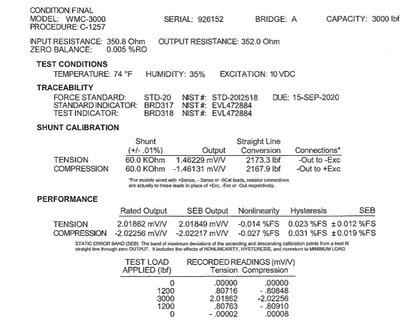- Subscribe to RSS Feed
- Mark Topic as New
- Mark Topic as Read
- Float this Topic for Current User
- Bookmark
- Subscribe
- Mute
- Printer Friendly Page
How to read mV/V output
07-09-2019 06:27 PM
- Mark as New
- Bookmark
- Subscribe
- Mute
- Subscribe to RSS Feed
- Permalink
- Report to a Moderator
Hello LabVIEW Community,
I am having some difficulty with data acquisition for a load cell. It uses a mV/V output which I am not familiar with. I understand that the signal output will be X.XX mV per volt of the excitation voltage.
Below is the pinout diagram.
The load cell is ~2.00 mV/V of the supply voltage at the full force. Also pictured below is the calibtation sheet.
My initial plan was to measure the output voltage using a high resolution voltage output card, NI9207. I figured I would be able to read the small mV output voltages well enough with this. However, in actual practice this is not working to get me good data.
Is there another method I should be trying with this? Some other cards I have are NI 9236, NI 9234, and NI 9214.
How can I verify the load cell is reading correctly?
Thanks in advance for the help.
-Josh
07-10-2019 06:23 AM - edited 07-10-2019 06:28 AM
- Mark as New
- Bookmark
- Subscribe
- Mute
- Subscribe to RSS Feed
- Permalink
- Report to a Moderator
Hello
I used NI 9237, so for your application NI 9236 should work fine.
I assume you have reading set up okay (card recognised and set up in NI MAX, reading of data output in Labview).
The output data amplitude is really small as you've noticed, in low load conditions even in ten thousands of mV/V. What you need to do is filter it as it is noisy, especially if you use long cables to connect to your load cells. Several different ways of doing the filtering, but easiest and most simple is doing a mean of X samples (from my experience 50 samples reduces the noise well, while not increasing rise time during changes too significantly).
In my application before filtering i couldn't measure reliably anything below 1kg without significant error, while after filtering i could measure the weight of a pen (~10g). The application was set up to measure forces from 1N to 100N.
Edit: forgot to mention i also took 1000 samples at the start of application, averaged them and subtracted from raw input, to zero out the input while not under load.
Hope this helps,
Best regards
07-10-2019 07:35 AM - edited 07-10-2019 07:45 AM
- Mark as New
- Bookmark
- Subscribe
- Mute
- Subscribe to RSS Feed
- Permalink
- Report to a Moderator
@jgreen19996 wrote:
How can I verify the load cell is reading correctly?
Thanks in advance for the help.
-Josh
The mV signal you acquire at the cRIO is the "raw" signal. It is called mv/V because ideally, if one doubles the excitation voltage, he gets twice as many minivolts at the same load applied. Normaly +1VDC or +3.3VDC are enough, using much more might case overheating. You can set the excitation level in the settings of your NI-923x.
In your VI you can perform basic addition and multiplication operations on your raw AI signal since it now is digital (back in the day, bridge amplifiers, where in the size of a shoe box and they returned you an analog value, normaly stretched to the range of +-10V, but still very reliable). Keep in mind, that you have to add/multiply with offsets and scale factors in the correct order, according to the cell specifications.
Verifying that the load cell is reading correctly can be performed with a precision scale. With no load attached, your should get a value of zero after conversion. With nominal positive (and then negative) load attached you should get this load read out in the VI.
Good luck at finding a suitable scale^^


